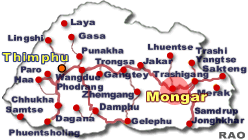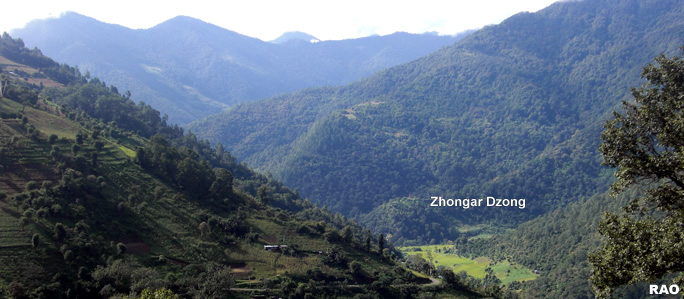 |
Bhutan's
Culture Dzongs |
|
 |
Bhutan Information |
|
|
|
 |
|
Zhongar Dzong - Zhongar's facelift halted in the absence of funds
|
 |
 |
A project to give a facelift to the ruins of Zhongar dzong in Mongar so that it becomes a tourist site has stopped with funds running out.
The ruins of the dzong, with its Utse (central tower)still standing, can be seen from the Mongar - Trashigang highway standing on a hillock between Lingmithang and Thidangbi village.
|
"The ruins are not at all safe for visitors so restoration would require quite a substantial amount of fund," Mongar dzongda Sherab Tenzin said.
The renovation project that took off in 2007-08, cleared the thick undergrowth around the dzong and some repairs were done on the compound wall of the courtyard. The shabkor (residence) was also straightened out, dzongkhag officials said.
The footpath to chudzong, which is about 30m below the dzong was also constructed by locals.
"The traditional Zhongar dzong will remain as it is but the utse (tower) will be reconstructed," Tshering Nidup, the district engineer said. "We did not touch the Utse because of the lack of budget."
The dzongkhag officials said remaining work includes tracing out the previous shape and replacing the wooden window frames. Dzongkhag officials said they were waiting for further directives from the authorities concerned.
As per the plan, there won't be a road connection to the ruins from the Menchugang-Broksar road. Instead developing a trekking route is on the cards via a small thick forest surrounding the old fortress.
There is no written record of when the dzong, which served as a seat to many powerful dzongpons in eastern Bhutan, was built.
Local people believe that Gyalpo Karpodhung invited bzochen Bala, from Paro, believed to be an extremely gifted carpenter at the time, to build the dzong.
But the king began to worry that Bala might build another dzong of greater wonder. So on the eve of Bala's journey back to Paro, the king cut off his right hand during chelchang (departure drink) arranged at Zhugthri.
In agonizing pain Bala prayed that the king must also die in pain, and that when he (Bala) was dead, he should be born as a demon (bdud) of the dzong and surrounding lands. Locals believe that Bala was born as a giant snake, which still guards the ruin of the dzong.
Even till this day locals say the place is lurking with malevolent spirits and a gigantic snake.
| Contributed by Tshering Namgyal, KUENSEL, Bhutan's National Newspaper, January 2012 |
 |
top
| Information on Bhutan |
 |
|





